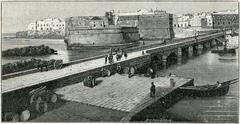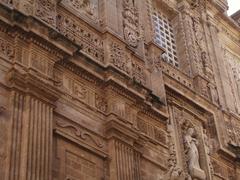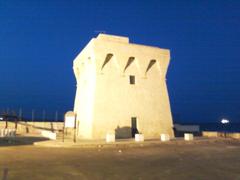
Guide to Visiting Castello Di Gallipoli, Gallipoli, Italy
Date: 16/08/2024
Introduction
Castello di Gallipoli, prominently situated in the picturesque town of Gallipoli, Italy, is a fortress of profound historical and architectural significance. This ancient structure, with origins tracing back to the Roman era, has witnessed a myriad of transformations under various ruling powers, including the Byzantines, Normans, Angevins, and Aragonese (Spotting History). Its strategic location on the Ionian Sea made it a critical defensive stronghold, protecting the town from numerous invasions over the centuries. The castle’s architectural evolution, from medieval fortifications to Renaissance enhancements, showcases the ingenuity of notable architects like Francesco di Giorgio Martini (Gallipoli Experience).
Today, Castello di Gallipoli stands not only as a symbol of resilience and strength but also as a vibrant cultural hub. Reopened to the public in 2014, the castle has become a popular tourist destination, offering visitors a unique blend of historical insights, architectural marvels, and cultural activities (Live the World). Whether you’re a history enthusiast, an architecture lover, or simply seeking a unique travel experience, Castello di Gallipoli promises to captivate your senses and ignite your imagination.
Table of Contents
- Introduction
- Historical Background
- Architectural Features
- Strategic Importance
- Cultural Significance
- Visitor Experience
- Practical Information
- Travel Tips and Nearby Attractions
- Special Events and Guided Tours
- FAQ
- Conclusion
Historical Background
Origins and Early History
The origins of Castello di Gallipoli can be traced back to the Roman era, when the site was initially fortified to protect the town from invasions. The strategic importance of Gallipoli, located on the Ionian Sea, made it a valuable asset for various ruling powers throughout history. The initial fortifications were expanded by the Byzantines and later by the Normans, who recognized the need for a robust defensive structure (Spotting History).
Medieval Transformations
During the 13th and 14th centuries, the castle underwent significant modifications under the rule of the Angevins and the Aragonese. These changes were primarily aimed at enhancing the defensive capabilities of the fortress. The Angevins added a square base strengthened by four towers, while the Aragonese further fortified the structure (Live the World).
One of the most notable architects involved in the castle’s transformation was Francesco di Giorgio Martini, a Sienese architect and engineer. Martini’s contributions included isolating the castle on all sides with a navigable ditch and designing the Rivellino, a fifth circular tower separated from the rest of the walls (Gallipoli Experience).
Renaissance and Baroque Periods
The Renaissance period saw further enhancements to the castle’s architecture. The moat surrounding the castle was filled in during the 19th century, and the arches that supported the lift bridge were also filled in. These changes were part of a broader effort to modernize the fortress and adapt it to new military technologies and strategies (Spotting History).
19th Century to Present
In the 19th century, the castle’s moat was filled, and the fish market that covered the facade was built. These changes marked a shift from the castle’s purely defensive role to a more integrated part of the town’s daily life. The fortress remained largely unchanged until the second half of the 19th century, when it underwent further modifications to accommodate the needs of the growing town (Gallipoli Experience).
Reopened to the public on July 5, 2014, the Castello di Gallipoli has since become a popular tourist destination. Visitors can explore the galleries, passages, and underpasses of the ancient fortress and enjoy the splendid panorama from the terraces (Gallipoli Experience).
Architectural Features
The Castello di Gallipoli is renowned for its architectural marvels. One of the highlights is the spectacular Hall Ennagonale, a grand hall with nine sides that exudes elegance and grandeur. The Circular Halls offer a striking echo effect, adding a touch of mystery to the castle’s ambiance. The women’s gallery provides a unique glimpse into the castle’s past, and the Tudor arch is a remnant of the fortress’s original entrance (Live the World).
Strategic Importance
The strategic importance of Castello di Gallipoli cannot be overstated. Its location at the entrance of the old town made it a critical point of defense against invasions. The castle’s fortifications have withstood numerous battles over the centuries, serving as a symbol of resilience and strength. Exploring the castle allows visitors to immerse themselves in the rich history of Gallipoli and gain a deeper understanding of its cultural heritage (Live the World).
Cultural Significance
Today, Castello di Gallipoli serves as a cultural hub, hosting national and international events and exhibitions. The castle’s transformation from a defensive stronghold to a center of cultural activities reflects the evolving role of historical sites in contemporary society. Visitors can enjoy a range of activities and attractions, including panoramic views of the Adriatic Sea, stunning architecture, and intricate interior details (Live the World).
Visitor Experience
A visit to Castello di Gallipoli is a journey through time, where history and architectural marvels intertwine. The castle offers a captivating atmosphere, rich heritage, and breathtaking views that leave an indelible mark on visitors. Whether you’re a history enthusiast, an architecture lover, or simply seeking a unique experience, Castello di Gallipoli is a must-visit destination that will captivate your senses and ignite your imagination (Live the World).
Practical Information
The entry fee for Castello di Gallipoli is 7 euros. For the latest information on opening hours and tickets, visitors can check the official website (Italy Travel Expert). The castle is located at Piazza Imbriani, 73014 Gallipoli, Italy, making it easily accessible for tourists exploring the old town (Goats on the Road).
Travel Tips and Nearby Attractions
When planning your visit to Castello di Gallipoli, consider exploring nearby attractions such as the picturesque old town, the beautiful beaches, and the vibrant local markets. Guided tours are available for those looking to delve deeper into the history and architecture of the castle.
Special Events and Guided Tours
Castello di Gallipoli hosts a variety of special events throughout the year, including historical reenactments, art exhibitions, and cultural festivals. Guided tours are available for an enriched experience, providing detailed insights into the castle’s history and significance.
FAQ
What are the opening hours of Castello di Gallipoli?
The opening hours vary by season. It is recommended to check the official website for the most up-to-date information.
How much is the entry fee for Castello di Gallipoli?
The entry fee is 7 euros.
Are there any guided tours available?
Yes, guided tours are available and can provide a deeper understanding of the castle’s history and architecture.
Conclusion
In conclusion, Castello di Gallipoli serves as a remarkable testament to the rich history and cultural heritage of Gallipoli. From its origins as a Roman fortification to its role as a cultural hub today, the castle has continuously evolved, reflecting the town’s resilience and adaptability through the ages (Spotting History). Visitors to the castle can explore its storied past, marvel at its architectural grandeur, and participate in various cultural events and exhibitions. The castle’s strategic importance, coupled with its transformation into a center for cultural activities, underscores its enduring significance in contemporary society (Live the World).
A visit to Castello di Gallipoli offers a journey through time, providing a deeper appreciation for the historical and cultural fabric of Gallipoli. Whether you’re walking through its ancient passages, enjoying the panoramic views from its terraces, or engaging in guided tours, the castle offers an enriching and memorable experience. For the latest information on visiting hours, tickets, and upcoming events, be sure to check the official website or download our app for real-time updates. Embrace the opportunity to explore this historical gem and immerse yourself in the captivating history and culture of Gallipoli.
References
- Spotting History. (n.d.). Gallipoli Castle. source url
- Live the World. (n.d.). Castello Gallipoli. source url
- Gallipoli Experience. (2020, December 15). Cultural Heritage. source url
- Italy Travel Expert. (n.d.). Gallipoli. source url
- Goats on the Road. (n.d.). Best Things to Do in Gallipoli. source url
- Jetsetting Fools. (n.d.). Daytrip to the Coast Gallipoli Italy. source url
- The Globetrotting Teacher. (n.d.). Things to Do in Gallipoli Italy. source url
- The Discoveries Of. (n.d.). Things to Do in Gallipoli Puglia. source url




